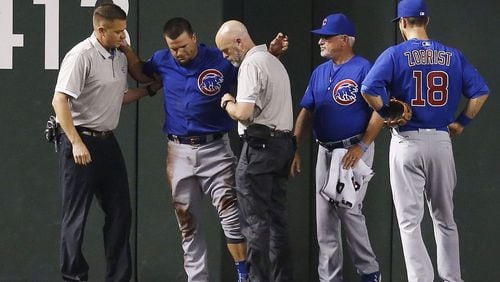When Cubs left fielder Kyle Schwarber collided with Dexter Fowler last month and was carted off the field with a torn left ACL, it was a reminder of one of sports most painful truths.
"It's a cruel, cruel game sometimes," Cubs manager Joe Maddon said afterward.
There was another reminder this spring when Illinois wide receiver Mikey Dudek tore his right ACL for the second-straight season during spring practices. Shortly after, running back Dre Brown tore his left ACL, also suffering the same injury that will sideline him for a second-straight season.
"The game sometimes can be cruel," Illini coach Lovie Smith said, echoing Maddon.
And after Derrick Rose tore his left ACL in 2012 a year following his MVP season, he said it was "the closest thing to death."
What makes an ACL tear so devastating isn't the pain or surgery. It's the recovery, which for athletes is often isolating, grueling and psychologically difficult.
"Every game I wasn't playing in was really tough," said former Northwestern receiver Christian Jones, who tore his right ACL as a high school senior and his left before his senior year with the Wildcats. "When you get to camp you take the mindset of this is it and then to have abrupt change of plans, it plays with your mind. It really was a hard transition."
Two days after Schwarber's injury, he vowed to return "bigger, faster, stronger" to the team. "You have to face it head on," he told reporters in early April. "I'm not going to back down from it."
It's a good mindset, but it's a hard one to maintain through recovery, which takes six months to a year.
"It's also how you define recovery," said Brian Cole, Bulls team physician and orthopedic surgeon at Rush University Medical Center in Chicago. "The lay person will say it's when they can get back to the sport. But it's not just when they can just get back but when they perform at the level they did before their injury. It depends on their sport and the position that they play."
Schwarber's ACL was reconstructed and his LCL repaired by Daniel Cooper, the head team physician for the Cowboys, and the procedure did not reveal nerve damage. ACL reconstruction surgery replaces the ligament in the center of the knee, which keeps the shin bone in place, with a graft either from one's own body or with a cadaver ligament.
The ligament, one of four major ones of the knee, is vital to athletes because it prevents forward movement of the tibia and provides roughly 90 percent stability in the knee joint, according to the Centers for Disease Control and Prevention.
During rehabilitation, the first goal is to regain range of motion in the knee. An early indicator of success is a patient's ability to achieve full extension, Northwestern athletic trainer Tory Lindley said. Athletes then move on to increasing strength with their foot off the ground, then putting weight on it and then progressing to sports specific movements.
Keeping players motivated through rehabilitation is difficult, Lindley said.
"It's like the seasons of a year," he said. "At first, it's a novelty, then you deal with winter, then you get to spring ... and now (after progress) we have to work on the opposite and hold them back from their own competitive nature."
Returning to competition is difficult, said Jones _ the former Northwestern receiver _ because teammates have made progress on the field while the patient almost solely has been rehabilitating. Then there is trying to forget about the risk of re-injury.
"You just have to trust the work you did," he said. "It's in the back of your head but then you get in heat of moment and at some point you say, '(Expletive) it.' You can't hold yourself back."
It's particularly difficult for female athletes who have a rate of ACL tears anywhere from two to eight times greater than male counterparts, according to studies. Former Sky guard Jacki Gemelos can relate _ arguably more than anyone who has ever had an ACL tear. She has had five.
The first was the last game of her senior year of high school, then at USC she needed four more reconstructive surgeries. Three were her right knee and two were her left.
Gemelos spent six years at USC but played in only 57 games. She finally made a WNBA roster last season with the Sky before being waived last week.
"I was a mess pretty much," she said recently. "That's probably where I grew the most as a player, mentally having to go through that injury constantly. There were a lot of lows and not many highs. For me, I would be cleared for a month or two and then tear it again. It was hard."
Studies show anatomy plays a part in the amount of ACL injuries females suffer.
Women tend to have stronger quadriceps than hamstrings and are more likely to use the quad to slow down, which causes instability in the knee, according to multiple studies.
Some studies also show that differences in hormones like estrogen and relaxin, which give ligaments strength and flexibility, are factors.
The approach to ACL injuries has changed significantly over the years.
In the 1960s and '70s, doctors would put the leg in a cast after surgeries.
"Your leg would turn to stone," Cole said. "You would get stiff and potentially get arthritis. We've come a long way in terms of understanding the rehab, the timing of surgery, the surgical techniques based in part on what we've learned in the laboratory, in terms of how we position the grafts, the choice of grafts, looking at outcomes."
According to the CDC, as many as 250,000 Americans suffer ACL tears yearly, resulting in health care costs exceeding $2 billion annually. Some medical experts attribute that to overtraining and year-round athletics among the nation's youth, especially females who are playing at a greater rate than ever.
"So if we've had a higher increase, which most of us believe to be true, it is because the opportunity to play sports (has increased)," Cole said. "The athletes are getting strong and faster, and the energy that goes into these sports is getting higher and more profound."
There is conflicting information on whether the ACL injury rate is increasing among college and professional athletes, as it is among the general population that has become more active in sports at a younger age.
Researchers from the University of North Carolina found that the risk for reinjury of an ACL decreases as an athlete matures from high school into college with most injured college players returning to their sport after an ACL surgery.
There are no extensive studies on ACL injuries among professional and college athletes. But from 2002-2012, the NFL averaged 43 ACL-related injuries per season, according to the American College of Sports Medicine. In 2013, the number jumped to 65.
In 2012, Rose was the first NBA All-Star to tear his ACL since Danny Manning in 1995, according to basketballprospectus.com. But an average of 4.5 players per year have suffered the injury since then. Sporting News reported five ACL injuries in 2011-12 and six in 2012-13.
Despite those spikes, however, doctors and athletic trainers don't believe the increases are a trend.
Those who suffered their original ACL tear in college had only a 2 percent chance of tearing it again and an 11 percent chance of tearing the other knee, while those who tore it in high school had a 17 percent injury rate in the original ACL and a 20 percent chance with the other knee.
A 2006 study from the American Journal of Sports Medicine showed that 63 to 80 percent of NFL players with ACL injuries returned to competition after rehab. Production from running backs and receivers though was reduced 33 percent, according to the study that measured their power rating.
In the NBA, a study showed 78 percent returned to play with 44 percent showing a decrease in scoring of at least one point per game after their return, according to a 2009 study in the medical journal Arthroscopy.
For baseball players like Schwarber, an ACL tear is rare. Some in baseball athletic training are pushing for more studies on baseball knee injuries.
In baseball, ACL tears are much less common. Overall knee injuries compose only 7.7 percent of all injuries in Major League Baseball, according to the medical journal Arthroscopy.
A study in Arthroscopy showed that 23 of 26 position players (88 percent) returned for at least 30 major league games after their rehab. Forty percent of those players, like Schwarber, injured their rear power-generating batting leg.
On average, there was a decrease of 21.2 percent in the number of games played in the season after injury by those returning players.
Despite some high profile injury tears and spikes of the injury in the NFL, doctors and athletic trainer warn against believing this as a long-term or significant increase among pro athletes.
"It is not an epidemic increase," Cole said.
But the injury is one that requires patience _ for the athletes and for the fans.
One MLB medical source said he expects Schwarber to return fine for spring training and that his age (23) is a factor in his favor even at a position so physically demanding as catcher. The Cubs just shouldn't "get crazy" and expect him to return for the playoffs this year.






